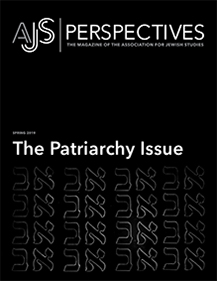In an issue devoted to patriarchy, I want to think about brotherhood. In The Politics of Friendship, Jacques Derrida examines the brotherly nature of friendship and political community, arguing that any society based on fraternity is exclusionary. If communities are structured through “the economic, genealogical, ethnocentric, androcentric features of fraternity,” then how can we begin to think beyond the fraternal? I propose that we examine the vertical problem of patriarchy through the horizontal sphere of fraternity in Modern Jewish Thought. Doing so will allow us to consider how the field has historically belonged to a “familial, fraternalist” configuration. More broadly, we will see that necessary critiques of patriarchy should be paying attention to the primary organizing principle of fraternity.
At the heart of Franz Rosenzweig’s major work, The Star of Redemption (1921), lies an evocative reading of the Song of Songs. I am intrigued by Rosenzweig’s compelling interpretation; while the Song of Songs is usually seen to focus on a heteroerotic relationship between lovers, Rosenzweig homes in on the lovers’ wish to become like siblings. But his reading is marked by fraternal tropes and the subsequent effacement of gender difference. He transposes the erotic energy in the Song from a celebration of difference to a longing for sameness. This transposition involves a move from revelation to communal redemption, as the erotic sphere is surpassed by neighborly “brotherliness.” For Rosenzweig, the anthropocentric and theocentric are not separable, and the language of brotherhood is not exclusive to one sphere or another. In his reading, the Song’s lovers long to be united in societal fraternity. While this may suggest a neutrality of gender, it is only attained by eliding sibling difference. As the lover/beloved erotic plane is left behind, all become equal as brothers. Along the way to this shared kinship, the feminine is left behind and sexual difference becomes effaced. That all are united in the kingdom of brotherliness, the Reich der Brüderlichkeit, suggests that all are only equal insofar as all are masculine.
My reading is influenced by Elliot Wolfson’s explanation of a fundamental motif in kabbalistic literature, in which the feminine becomes masculine in a reconstituted male androgyne: “In the ideal state, gender differentiation is neutralized and the female is absorbed back into the male.” A similar transmutation takes place in Rosenzweig’s reading of the Song, as all are united in brotherliness and attain equality under the bearing of the masculine. As Zachary Braiterman and Mara Benjamin have observed, Rosenzweig’s version of intersubjectivity gives way to a homosocial community, a Männerbund. Here Jacques Derrida’s critique of fraternity becomes particularly relevant: “The fratriarchy may include cousins and sisters but, as we will see, including may also come to mean neutralizing.”
If we view patriarchy as a network of interconnected relationships, we can see how horizontal relationships make vertical power structures possible. In the classical politics of friendship, brotherhood is crystallized in the communal bond. The ethical relation is figured as a friendship inseparable from fraternity— Platonic, free equals taking part in a homosocial bromance. Any relation of solidarity among nonbrothers is then only thinkable on the model of fraternization.
In my view, the model of brotherhood structures both the philosophy/ theology of Rosenzweig and the ethics of Emmanuel Levinas. In the move from the familial to the social level, society is construed as a relationship of brothers, in which every self is commanded to ethical relations with others because of this shared kinship. As Levinas writes in Otherwise than Being: or, Beyond Essence (1974), “The other is from the first the brother of all the other men.” What happens when a celebration of difference is set aside in service of a unifying fraternal community? Brotherhood may appear to be an admirable ethical aim, but it requires dissolving the particularities of identity.
We should interrogate and make explicit the structural organizations that drive these philosophical approaches. In these works, fraternity functions on the level of both form and content—as a network of male thinkers who operate in relation to one another, and as a trope that shapes their methodologies. This coincidence is not accidental. How do these themes shore up ethical approaches that privilege the masculine? This is both a hermeneutical limitation and an ethical problem. What would the accepted canon of Modern Jewish Thought look like beyond, in Derrida’s words, “the homo-fraternal and phallogocentric schema” of the fratriarchy—beyond the old male thinkers’ club? What questions and interpretations are overlooked? How does this extend to our pedagogy—to the homogenous names on our syllabi? One could maintain that a syllabus on Jewish Thought (or any area of Jewish Studies) should reflect the field; since this is how the field was historically constructed, this is how our syllabi should look. Instead, I suggest we critically examine our syllabi and the edited volumes from which we teach, exposing students to productive anachronistic and thematic frameworks that include overlooked methods. In a class on Spinoza, we might assign a contemporary essay on embodiment, or alongside Levinas, an essay highlighting the blind spot of sexual difference.
Luce Irigaray and Derrida observe that Levinas’s work is novel, even radical, because it is explicitly sexed male—unlike Heidegger’s Dasein, or countless other works and concepts in the history of Western thought that presume to be unsexed and therefore underwrite a masculine norm. Taking a cue from Irigaray and Derrida, we can emphasize the positionality of the author rather than reflexively assigning them a normative neutrality. In doing so, we will reveal and disrupt power relations already at work in the texts we select. We can expand our notion of Jewish Thought to include alternate forms, affective networks, and nonsystematic, poetic, and epistolary sources: What other voices would be admitted if we accepted letter-writing, memoir, and testimony as accepted categories? A responsible and critical ethics of reading can lead to a more inclusive field of study. Once we start, we’ll realize that it’s not difficult to de-broify our Jewish Thought syllabus/ canon. But we have to start.

